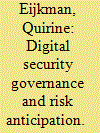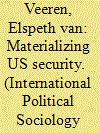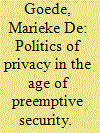|
|
|
Sort Order |
|
|
|
Items / Page
|
|
|
|
|
|
|
| Srl | Item |
| 1 |
ID:
130986


|
|
|
|
|
| Publication |
2014.
|
| Summary/Abstract |
Until 2012, Omar Khadr was both the only former child soldier and Western national left in Guantanamo Bay. Captured by US forces at the age of 15, this Canadian youth would spend more than 40% of his life in US custody during the War on Terror. This article advances two key arguments. First, as a child soldier, Khadr is simultaneously cast as an object of sympathy and suspicion. The construction of Khadr's childhood is animated by a cultural racism, which casts Khadr as both a victim of an extremist family and the evil outcome of a "jihadi" upbringing. Second, this article examines competing culturally racialized claims about citizenship, prompted by the failure of the Canadian government to seek Khadr's repatriation. While the central preoccupation of liberal citizenship discourse is the erosion of Canada's identity as a Western, liberal democracy, "racial-nationalist" discourse raises the alarm on the threat posed by "citizens of convenience" who must be cast out of the polity through practices of "pure exclusion."
|
|
|
|
|
|
|
|
|
|
|
|
|
|
|
|
| 2 |
ID:
130988


|
|
|
|
|
| Publication |
2014.
|
| Summary/Abstract |
The Eastern enlargement of the European Union has intensified calls for the reconstruction of a common European remembrance of the continent's multiple totalitarian legacies. Various political initiatives to condemn, along with counter-attempts to re-legitimize, the legacy of communism have emerged at the pan-European level. Each aspires to leave an imprint on the symbolic moral order and the legal regime of the broader European community. This article builds a conceptual framework for understanding the contestation of political and juridical regulation of the transnational remembrance of totalitarian communist regimes in Europe. Critically engaging the concept of cosmopolitanization of memory, it is argued that mnemonic identity in Europe is being transformed via new claims on "European memory." These claims are being made by various East European actors seeking recognition of the region's particular historical legacies as part of the pan-European normative verdict on twentieth-century totalitarianisms.
|
|
|
|
|
|
|
|
|
|
|
|
|
|
|
|
| 3 |
ID:
130992


|
|
|
|
|
| Publication |
2014.
|
| Summary/Abstract |
How to Engage with the Politics of Privacy in the Age of Preemptive Security? My suggestion is to start with data protection, which, following De Hert and Gutwirth (2006), is not exactly the same of privacy. Extrapolating from their analysis of the two as different "legal tools," I would say that privacy and data protection are two slightly different rationales of power relations: one of privacy based on the "opacity of the individual" and one of data protection on the "transparency and accountability of the powerful" (Gutwirth and De Hert 2008:275; emphasis in original).1 These rationales (attempt to) orientate two different loose dispositifs, each formed by a composite ensemble of elements. Some of these elements are peculiar to each dispositif, while others are shared or encompassed by both
|
|
|
|
|
|
|
|
|
|
|
|
|
|
|
|
| 4 |
ID:
130993


|
|
|
|
|
| Publication |
2014.
|
| Summary/Abstract |
The anticipatory turn in managing security and safety relies not only on innovative technological tools, but also on social practice. New information and communication technology, for instance, facilitates digital security governance1 which entails the collection, processing, storage, and sharing of digital personal data for risk profiling, but little is known about the role of security officials in preemptive security. Although people, or "data subjects," are categorized according to a (predefined) level of potential threat on the basis of digital data, it is often unclear which actor or agency was responsible for this categorization. This is especially unclear when information was shared across the globe between several security agencies and/or private companies. Nonetheless, as the assessment of risk or dangerousness affects someone's real-life opportunities, privacy rights or claims to something or someone are likely to be evoked.
|
|
|
|
|
|
|
|
|
|
|
|
|
|
|
|
| 5 |
ID:
130984


|
|
|
|
|
| Publication |
2014.
|
| Summary/Abstract |
The study of emotion has become a steadily growing field in humanitarian actions. This essay adds to the field through a further empirical examination of the political roles emotions can play. Specifically, the essay questions how emotions were implicated in the construction of transnational solidarity-and the associated humanitarian actions-following an event of pivotal global importance: the Asian tsunami disaster of December 2004. To this end, I focus on the emotional dimensions of dominant media tsunami imagery and examine how emotions helped to produce the humanitarian meanings and ideologies on which the subsequent solidarity and humanitarian actions were based. Analyzing photographs in the New York Times, the essay demonstrates that the dominant tsunami imagery helped to evoke solidarity and garner aid. It did so, at least in part, through mobilizing stereotypical and deeply colonial representations of developing world disaster that are suggestive of a "politics of pity." In this way, the essay contributes both an empirical study of emotions in world politics and an examination of the linkages between emotions and contemporary humanitarianism.
|
|
|
|
|
|
|
|
|
|
|
|
|
|
|
|
| 6 |
ID:
130985


|
|
|
|
|
| Publication |
2014.
|
| Summary/Abstract |
While a growing body of literature working at the intersection of security and visual studies recognizes the value of studying images, how these visualities are produced is less theorized, especially with respect to materialities and their capacity to compel meanings. Analyzing the tours of Joint Task Force Guantanamo, which have been arranged by the US military for VIP visitors since the site opened, this article argues that the selective organization and presentation of specific matter was image-making and therefore meaning-making. Through efforts to produce a spectacle of detention, Guantánamo was deliberately constructed as "safe, humane, legal, transparent"-in the process shifting the meaning of these very concepts. Guantánamo's tours as visual and material practices were therefore used to produce meaning in the debate over the future of the site and how best to secure the US state post-9/11. They were part of the constitution of the war's legitimacy, leading, ultimately, to certain understandings of security. Guantánamo, with its "object lessons" and "concrete messages," is therefore a useful case study for understanding security meaning-making as produced by the interaction of linguistic, visual, and material domains and their elements.
|
|
|
|
|
|
|
|
|
|
|
|
|
|
|
|
| 7 |
ID:
130989


|
|
|
|
|
| Publication |
2014.
|
| Summary/Abstract |
In August 2013, a report was leaked to the Washington Post in which it was revealed that the US National Security Agency (NSA) violated its own privacy rules 2,776 times over a one-year period (Gellman 2013). The privacy violations documented in the report range from technical errors to serious violations such as operations without consent from the Foreign Intelligence and Surveillance (FISA) court and breach of the five-year data retention period. Other breaches are described as "broad syntax" errors, which are related to imprecise queries. This type of fault is presumed reducible "if analysts had more complete and consistent information available about … targets."1 Following the recent disclosures concerning the NSA's PRISM program, which has the capacity to search and connect numerous social network databases in the name of security, the importance of the publication of this privacy report cannot be overestimated. While much of the public discussion concerning PRISM has so far focused on the person of Edward Snowden and his unlikely journeys to Hong Kong and Russia, relatively few questions have been raised about the value and legitimacy of the PRISM program itself. The Washington Post revelations concerning the NSA privacy breaches have grabbed the headlines and may lead to Congressional Hearings (Blake 2013). As with other security and surveillance programs, privacy is a key anchor for critical questioning and public debate
|
|
|
|
|
|
|
|
|
|
|
|
|
|
|
|
| 8 |
ID:
130991


|
|
|
|
|
| Publication |
2014.
|
| Summary/Abstract |
When US President Barack Obama publicly addressed the data mining and analysis activities of the National Security Agency (NSA), he appealed to a familiar sense of the weighing of the countervailing forces of security and privacy. "The people at the NSA don't have an interest in doing anything other than making sure that where we can prevent a terrorist attack, where we can get information ahead of time, we can carry out that critical task," he stated. "Others may have different ideas," he suggested, about the balance between "the information we can get" and the "encroachments on privacy" that might be incurred (Obama 2013). In many ways, conventional calculations of security weigh the probability and likelihood of a future threat on the basis of information gathered on a distribution of events in the past. Obama's sense of a trading-off of security and privacy shares this sense of a calculation of the tolerance for the gathering of data on past events in order to prevent threats in the future. In fact, though, the very NSA programs he is addressing precisely confound the weighing of probable threat, and the conventions of security and privacy that adhere to strict probabilistic reasoning. The contemporary mining and analysis of data for security purposes invites novel forms of inferential reasoning such that even the least probable elements can be incorporated and acted upon. I have elsewhere described these elements of possible associations, links, and threats as "data derivatives" (Amoore 2011) that are decoupled from underlying values and do not meaningfully belong to an identifiable subject. The analysis of data derivatives for security poses significant difficulties for the idea of a data subject with a recognizable body of rights to privacy, to liberty, and to justice.
Consider, for example, two years before the controversies surrounding NSA and the PRISM program, when the US Director of National Intelligence, James Clapper, testified before the joint hearing of committees on the virtues of the algorithmic piecing together of fragments of data:
|
|
|
|
|
|
|
|
|
|
|
|
|
|
|
|
| 9 |
ID:
130987


|
|
|
|
|
| Publication |
2014.
|
| Summary/Abstract |
The securitization of the spaces of Israeli-Palestinian interaction, from checkpoints to the West Bank Separation Wall, continues to intensify and receive attention from journalists, scholars, and activists. Understandably, the focus is on the negative consequences of existing spatial configurations. Receiving far less attention is the development of alternative spatial formations which might advance forms of "desecuritization," especially in those spaces that are crucial hinges of Israeli-Palestinian interaction (Jerusalem and other mixed cities, the Wall, the Green Line, roads). This article explores whether alternative ways of using, organizing, experiencing, and coexisting in space-especially at the micro level-hold out promise for helping to reframe significant dimensions of Israeli-Palestinian interaction. It seeks to better understand whether disjointed forms of sovereignty that appear-or disappear-across the occupation can be met by counter-sovereignties; whether new spatial counter-realities can be articulated through everyday life; and whether forms of agency, especially contestation, can reset understandings of, and perspectives on, spaces. A range of examples are considered within Jerusalem, mixed cities, the occupied Palestinian territories and at the border, bearing on religious sites, healthcare, gentrification, security infrastructure, popular protest, and festivals
|
|
|
|
|
|
|
|
|
|
|
|
|
|
|
|
| 10 |
ID:
130990


|
|
|
|
|
| Publication |
2014.
|
| Summary/Abstract |
The reconfiguration of the security landscape in recent years has resulted in the transformation of the relationship between the individual and the state. A catalyst toward this transformation has been the growing link between securitization and preemptive surveillance, and the focus of security governance on the assessment of risk (Amoore and de Goede 2008). Central in this context is the focus on the future, and the aim of preemptive surveillance to identify and predict risk and dangerousness (Bigo 2006). The preemptive turn in surveillance has been based largely upon the collection, processing, and exchange of personal data, which has in turn been marked by three key features. The first feature involves the purpose of data collection and processing. This is no longer focused solely on data to address the commission of specific, identified criminal offenses, but focuses rather on the use of personal data to predict risk and preempt future activity. The second feature involves the nature of the data in question. On the one hand, preemptive surveillance focuses increasingly on the collection of personal data generated by ordinary, everyday life activities. This includes records of financial transactions (Mitsilegas 2003; de Goede 2012), of airline travel (PNR) reservations (Mitsilegas 2005), and of mobile phone telecommunications (Mitsilegas 2009). The focus on monitoring everyday life results in mass surveillance, marked by the collection and storage of personal data in bulk. On the other hand, the focus on prediction and preemption has been linked with the deepening of surveillance via the collection of sensitive personal data from the human body, such as DNA samples and biometrics (Lyon 2001; Amoore 2006). The third feature of preemptive surveillance involves the actors of surveillance. A key element in this context, linked with the focus on the monitoring of everyday life, is the privatization of surveillance under what has been named a "responsibilisation strategy," aiming to co-opt the private sector in the fight against crime (Garland 1996). Thus, banks and other financial and non-financial institutions (including lawyers), airlines and mobile phone companies are legally obliged to collect, store, and reactively or proactively transfer personal data to state authorities. The privatization of surveillance has been accompanied by the expansion of state actors of surveillance. Maximum access to databases has been allowed to security agencies, notwithstanding the purpose of the database. A prime example in this context is access by law enforcement authorities to immigration databases such as the EU Visa Information System (Mitsilegas 2012) which reflects what has been deemed the (in)security continuum, transferring the illegitimacy of criminality to immigration (Bigo 1996).
|
|
|
|
|
|
|
|
|
|
|
|
|
|
|
|
|
|
|
|
|